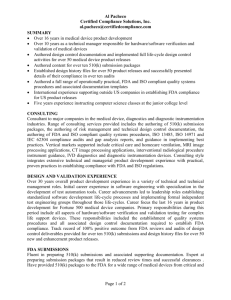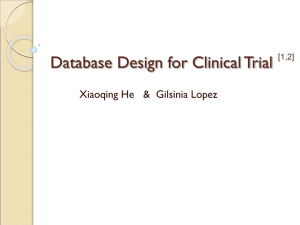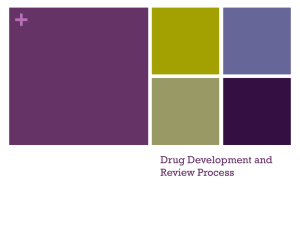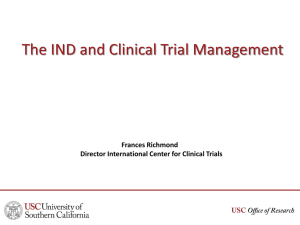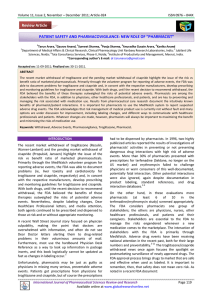ISO/TS 19218 WHO Informal Consultation on Nomenclatures for
advertisement
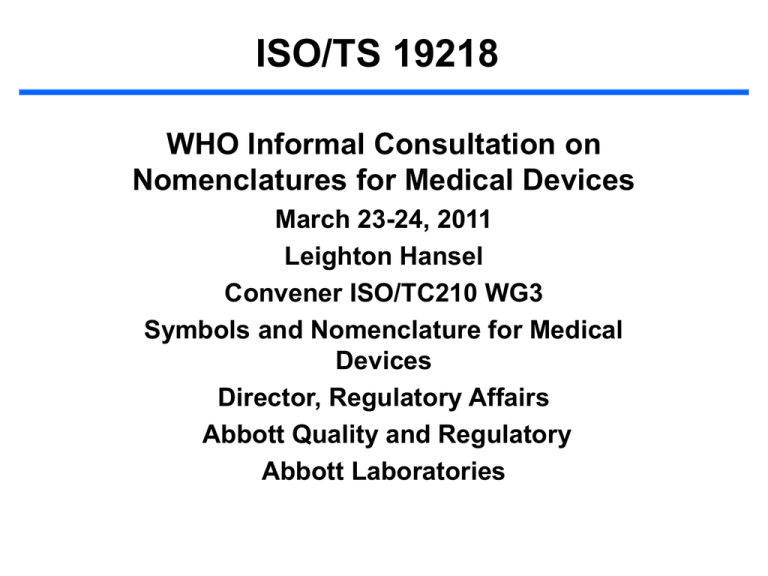
ISO/TS 19218 WHO Informal Consultation on Nomenclatures for Medical Devices March 23-24, 2011 Leighton Hansel Convener ISO/TC210 WG3 Symbols and Nomenclature for Medical Devices Director, Regulatory Affairs Abbott Quality and Regulatory Abbott Laboratories 1999 Proposed NWIP • Standard for coding device failures suggested to ISO/TC 210 WG 3, Symbols and Nomenclature for Medical Devices by FDA/GHTF SG2 • To support adverse event information exchange between regulatory authorities • Manufacturer submissions of adverse event reports to regulatory authorities. • Could also be used by end users • Excluded patient outcomes • For post market events, not for clinical studies 2 History of TS 19218 • NWIP approved 2000 • Background information gathered early 2002 • ISO/TC 210 WG 3, concluded that work should result in a Technical Specification • WD Prepared mid 2002 • Consulted with GHTF SG2 in 2003 • DTS Voted on early 2004 and revised • As result of preparing DTS2, WG3 concluded NWIP for introduction of hierarchical structure should be proposed • DTS 2 Voted on, revised and published as TS 19218:2005 • NWIP for hierarchical structure approved 2005 • WG3 Decided to split into 2 Documents, Event Type Codes(-1) and Evaluation Codes(-2) • 19218-1 Event Type Codes submitted for publication 2010 • Amendment 1 to 19218-1 coding examples under development • WG3 will review draft of 10218-2 in 2011 with publication in 2012 3 Initial Version of TS19218 • Development based on two documents – FDA Coding Evaluation Report – An Evaluation of the Coding System for Device Problems and Patient Effects Used to Report Adverse Medical Device Events to the FDA MedWatch Program – Report on Medical Device Fault Conditions (NKKN, Haukeland University Hospital) 4 Revised TS 19218 • WG revised to consist of event types and cause codes • Definitions – The adverse event type code characterizes the observed use/malfunction/failure of the medical device at the time the event occurred. – The adverse event cause code characterizes the latest conclusions of a cause analysis of the adverse event. • Number of codes – As Issued (2005) – 22 Type and 46 Cause 5 Device vs. Drug Report Numbers Country/Regulatory Authority US FDA Australia TGA Health Canada TPD Year Devices Drugs 2005 180,000 437,000 (213,000 – 15 day; 84,000 periodic serious injury; 140,000 periodic non serious, 136,000 e-sub) 2006 326,000 2005 174 472,000 (158,000 e-sub) 3,000 Drugs, 2005 Devices 2002 730 6500 Note: Over 60% of FDA’s 2005 device submissions utilized alternative summary reporting (ASR) 6 EU – Device Reports 7 Code Development/Use Considerations • Use of codes – Regulatory authorities • Level of detail related to size of regulatory authority and number of adverse event reports received • Level of detail for data exchange – Manufacturers – “Buckets” – Supplemental coding • IT applications as support tools • Maintenance 8 Example FDA Hierarchical Structure Device Code Hierarchy Device Issue Device Operational Issue - Issue associated with any deviations from specifications relating to device operations (e.g. deployment, connection, electrical, computer software, infusion/flow, output, protective measure, and incompatibility issues). Computer Software Issue - Issue associated with written programs, codes, and/or software system that affects device performance or communication with another device. Application Program Issue - Issue associated with the requirement for software to fulfill its function within an intended use or application. Programming Issue - Issue associated with the written program code or application software used to satisfy a stated need or objective for functioning of the device. These do not include issues associated with the operating system Incorrect Software Programming Calculations Dose Calculation Error due to Software Problem 9 Global Vision of Harmonized Event Type Codes • • • • Manufacturer Codes (XXX) FDA Codes (476) TS 19218 Level Two Codes (82) TS 19218 Level One Codes (20) 10 19218-1 Event Type Codes Level 1 Activation, Positioning, or Separation Computer Hardware Computer Software Connection or Fitting Electrical/Electronic External Conditions Implantable Device Failure Incompatibility Infusion/Flow Marking, Labeling or Instructions for Use Material Mechanical Non Mechanical Other Output Issue Packaging/ Shipping Protective Temperature Unintended Function Use Error 11 Example of Event Type Codes TS19218-1 12 Examples being developed for 19218-1 13 19218-2 vs. 19218:2005 19218-2 DRAFT Vs 19218:2005 1. Draft evaluation (cause) codes contains 21 Level 1 terms and 82 Level 2 terms 2. TS 19218:2005 contained 47 cause (evaluation) codes 3. Draft uses 42 TS 19218:2005 terms 14 Portion of Draft TS19218-2 15 Portion of Draft TS19218-2 16 Level 1 Terms – TS19218-2 Biological Design Electrical Interoperability Labelling Manufacturing Materials, chemistry Mechanical No device problem or failure detected Not device related Off label, unapproved, or contraindicated use Operational Problem (Functional deficiency) Optical Other Quality System Reuse of a single use device Software Tampering, counterfeiting, sabotage Test Results Unidentified 17



